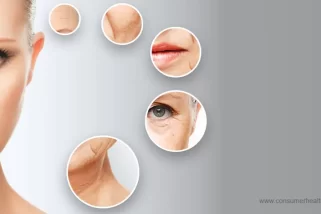In This Article
What is Photodynamic Therapy for Wrinkles?
Photodynamic therapy (PDT) is a medical treatment that uses a photosensitizing drug. This drug is activated when exposed to light, resulting in an activated oxygen molecule that has the ability to destroy nearby cells [1].

Certain types of cancer cells, as well as thin, superficial skin cancers (called actinic keratoses), can sometimes be eliminated using this method of treatment [2].
The procedure is performed in a physician’s office and is considered to be an outpatient procedure.
What Types of Conditions are Treated with Photodynamic Therapy?
In dermatology, PDT is often paired with a photosensitizer. It is used in the early treatment of thin skin cancers, as well as to treat acne, rosacea, skin cancer, sun damage, cosmetic skin improvement, warts, hidradenitis suppurative, psoriasis, oily skin, enlarged sebaceous glands, wrinkles, anti-aging treatments, and other skin conditions.
It is not used to remove moles or birthmarks. The FDA has approved PDT for non-small cell lung cancer, esophageal cancer and precancerous changes of Barrett’s esophagus [3].
How Does Photodynamic Therapy (PDT) Work?
There are three steps to PDT. A light-sensitizing liquid, cream or intravenous drug (the photosensitizer) is applied or administered to the area[1].
An incubation period, which can last anywhere from minutes to days, is the next step of the process.
Lastly, the target tissue is exposed to a specific wavelength of light, which then activates the photosensitizing medication.
Breaking down the steps:
- Application of photosensitizer drug
- Incubation period
- Light activation
What Does Photodynamic Therapy Treatment Involve?
Some patients receive a written procedure consent form to read and fill out before the procedure.
Pretreatment photography may be taken prior to applying the photosensitizer medication.
Treatment should take place in a treatment room.
Patients are typically lying in back in a comfortable position on the table.
Thorough cleansing of the face is often done first.
The skin will more readily absorb the applied topical medication if your skin is less oily.
A photosensitizing liquid or cream is applied topically to the area being treated and the medication is allowed to air dry for a few minutes.
An incubation time ranging from 30-60 minutes has to be gotten through before treatment can continue.
Areas such as the forearms, legs and back require incubation time of up to 18 hours for the best results.
Your physician will adjust incubation time depending on your skin type.
You will be brought back to the light-source room once your incubation time has been completed.
A wavelength light source will activate the medication.
You can expect to feel sensations of warmth, tingling, heat and in some cases, burning.
A fan is often used to help cool off during photodynamic therapy treatment.
Once this portion of treatment is over, the medication will be washed off and sunscreen will be applied to the treated areas.
Aftercare instructions are given to patients before they are sent home.
Photodynamic therapy is good but, if you want to use the eye cream for reducing wrinkle, then you can go through Plexaderm; which might be able to manage wrinkles and fine lines.
How To Perform?
Lighter or fair-skinned patients who have a sunburn, sun-damaged skin are usually the best candidates for PDT.
Dark-skinned patients tend to darken or discolor after this type of treatment and are typically not good candidates.
Patients who are sensitive to light or who burn easily are also not good candidates.
Patients who are taking certain medications or have jobs that require constant sun exposure would not make good candidates.
What are the Advantages of Photodynamic Therapy?
With PDT, treatment can selectively treat an entire area of skin damage. This is one of the greatest advantages of photodynamic therapy.
Treatment also greatly reduces the risk of skin spots.
It also can improve overall appearance, including smoothing out the skin. PDT is preferred by many patients because of the rapid recovery time.
What are the Limitations of PDT?
As great as PDT is, there are some limitations to the treatment. For starters, it requires the direction of the light to the appropriate site and tissue depth in order for the treatment to be effective.
Also, it is ablative, not yielding material for histological diagnosis, so it is important for diagnosis to be made before treatment.
The procedure is also considered to be a complex procedure that requires optimal light delivery with a laser, as well as collaboration and coordination between clinicians. It can also make the skin very sensitive to light for several weeks.
Does PDT Have Any Complications or Side Effects?
PDT varies from person to person, as does how the treatment is given. This is dependent on the person and their skin type.
Photodynamic therapy side effects will vary too according to what part of the body is treated, the type of photosensitizing drug given, the time between giving the drug and applying the light and the skin sensitivity to light following treatment.
3 Sources
We review published medical research in respected scientific journals to arrive at our conclusions about a product or health topic. This ensures the highest standard of scientific accuracy.
[1] Photodynamic Therapy for Premalignant Growths: https://www.asds.net/skin-experts/skin-treatments/photodynamic-therapy-for-premalignant-growths[2] Actinic keratosis: https://www.mayoclinic.org/diseases-conditions/actinic-keratosis/symptoms-causes/syc-20354969
[3] PHOTODYNAMIC THERAPY (PDT) USING HPPH FOR THE TREATMENT OF PRECANCEROUS LESIONS ASSOCIATED WITH BARRETT’S ESOPHAGUS: https://www.ncbi.nlm.nih.gov/pmc/articles/PMC3218433/









 This article changed my life!
This article changed my life! This article was informative.
This article was informative. I have a medical question.
I have a medical question.
 This article contains incorrect information.
This article contains incorrect information. This article doesn’t have the information I’m looking for.
This article doesn’t have the information I’m looking for.